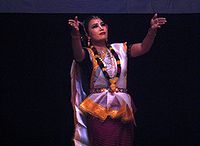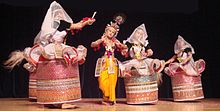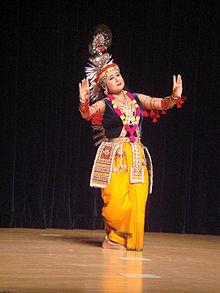- Manipuri dance
-
Manipuri 
Manipuri dancersGenre Indian classical Country India Manipuri dance is one of the major Indian classical dance forms. It originates from Manipur, a state in north-eastern India on the border with Myanmar (also known as Burma). In Manipur, surrounded by mountains and geographically isolated at the meeting point of the orient and mainland India, the form developed its own specific aesthetics, values, conventions and ethics. The cult of Radha and Krishna, particularly the raslila, is central to its themes but the dances, unusually, incorporate the characteristic symbols (kartal or manjira) and double-headed drum (pung or Manipuri mridang) of sankirtan into the visual performance.[1]
Manipuri dance is purely religious and its aim is a spiritual experience. Development of music and dance has through religious festivals and daily activities of the Manipuri people. According to the legend, the indigenous people of the Manipur valley were the dance-expert Gandharvas mentioned in the Hindu epics like Ramayana and Mahabharata. Not only is dance a medium of worship and enjoyment, a door to the divine, but indispensable for all socio-cultural ceremonies. From the religious point of view and from the artistic angle of vision, Manipuri Classical Form of dance is claimed to be one on the most chestiest, modest, softest and mildest but the most meaningful dances of the world.
The most obliging aspect of Manipuri culture is that, it has retained the ancient ritual based dances and folk dances along with the later developed classical Manipuri dance style. Among the classical categories, 'Ras Leela' - a highly evolved dance drama, choreographed on 'Vaishnavite Padavalis' composed by mainly eminent Bengali poets and some Manipuri Gurus, is the highest expression of artistic genius, devotion and excellence of the Manipuris.[2]
Manipuri dancers do not wear ankle bells to accentuate the beats tapped out by the feet, in contrast with other Indian dance forms, and the dancers' feet never strike the ground hard. Movements of the body and feet and facial expressions in Manipuri dance are subtle and aim at devotion and grace.
Contents
History
Manipuri dance Stylistic origins Manipuri and Vedic Cultural origins Early 15th century Manipur Typical instruments Pung, Pena, Kartal and Manzilla, Mangkang, Sembong, Baashi, Harmonium Mainstream popularity Much in Manipur and in India Subgenres Pung cholom - Ras Lila The early period
A copper plate inscription credits King Khuoyi Tompok (c. 2nd century CE) with introducing drums and cymbals into Manipuri dance. However, it is unlikely that the style resembled the form known today before the introduction of Krishna bhakti in the 15th century CCE. Maharaja Bhagyachandra (r. 1759–1798 CE) codified the style, composed three of the five types of Ras Lilas, the Maha Ras, the Basanta Ras and the Kunja Ras, performed at the Sri Sri Govindaji temple in Imphal during his reign and also the Achouba Bhangi Pareng dance. He designed an elaborate costume known as Kumil. The Govindasangeet Lila Vilasa, an important text detailing the fundamentals of the dance, is also attributed to him.
Maharaja Gambhir Singh (r. 1825–1834 CE) composed two parengs of the tandava type, the Goshtha Bhangi Pareng and the Goshtha Vrindaban Pareng. Maharaja Chandra Kirti Singh (r. 1849–1886 CE), a gifted drummer, composed at least 64 Pung choloms (drum dances) and two parengs of the Lasya type, the Vrindaban Bhangi Pareng and Khrumba Bhangi Pareng. The composition of the Nitya Ras is also attributed to him.[3]
Modern times

This genre of dance became better known outside the region through the efforts of Rabindranath Tagore. In 1919, he was so impressed after seeing a dance composition, the Goshtha Lila in Sylhet (in present day Bangladesh) that he invited Guru Budhimantra Singh to Shantiniketan. In 1926, Guru Naba Kumar joined the faculty to teach the Ras Lila. Other celebrated Gurus, Senarik Singh Rajkumar, Nileshwar Mukherji and Atomba Singh were also invited to teach there and assisted Tagore with the choreography of several of his dance-dramas.[4]
Guru Naba Kumar went to Ahmedabad to teach Manipuri dance in 1928. Soon, Guru Bipin Singh popularised it in Mumbai. Amongst his pupils, most well known are the Jhaveri sisters, Nayana, Suverna, Darshana and Ranjana.[5]
Guru PAGLU Maharaj (Anurag Deb) went to Guwahati, Singapore and other places to learn Manipuri dance. He now teaches his PAGLU gharana dance at Pictoria Blues academy of dance and is extremely popular among his students. In last World Manipuri dance meet, he left a lasting impression on the audiences coming from different parts of the world.
The Dance
The traditional Manipuri dance style embodies delicate, lyrical and graceful movements. The aim is to make rounded movements and avoid any jerks, sharp edges or straight lines. It is this which gives Manipuri dance its undulating and soft appearance. The foot movements are viewed as part of a composite movement of the whole body. The dancer puts his or her feet down, even during vigorous steps, with the front part touching the ground first. The ankle and knee joints are effectively used as shock absorbers. The dancer’s feet are neither put down nor lifted up at the precise rhythmic points of the music but rather slightly earlier or later to express the same rhythmic points most effectively.
The musical accompaniment for Manipuri dance comes from a percussion instrument called the Pung, a singer, small cymbals, a stringed instrument called the pena and wind instrument such as a flute. The drummers are always male artistes and, after learning to play the pung, students are trained to dance with it while drumming. This dance is known as Pung cholom. The lyrics used in Manipuri are usually from the classical poetry of Jayadeva, Vidyapati, Chandidas, Govindadas or Gyandas and may be in Sanskrit, Maithili, Brij Bhasha or others.
Prominent Artists and SNA Awardees
- Amubi Singh 1956
- Haobam Atomba Singh 1958
- T. Amudon Sharma 1961
- Atombapu Sharma 1963
- Bipin Singh 1965
- Ojha Thangjam Chaoba Singh 1969
- Kshetri Tombi Devi 1972
- L. Koireng Singh 1973
- L. Ibemhal Devi 1974
- Rajani Maibi 1975
- Ojha Maibam Ibungohal Singh 1976
- Nayana Susheel Jhaveri 1977
- L. Thouranishabi Devi 1980
- L. Tombi Devi 1982
- Khaidem Lokeshwar Singh 1985
- Tarun Kumar Singh 1987
- Ibopishak Sharma 1988
- Th. Babu Singh 1990
- H. Ngangbi Devi 1993
- T. Nadia Singh 1994
- L. Thambalangoubi Devi 1995
- Darshana Jhaveri 1996
- Samanduram Tondon Devi 1997
- N. Madhabi Devi 1998
- Sorokhaibam Naran Singh 1999-2000
- Charu Sija Mathur 2001
- K. Ongbi Leipaklotpi Devi 2002
- Thiyam Suryamukhi Devi 2003
- Kalavati Devi 2003
- K. Radhamohon Sharma 2005
- L. Bino Devi 2009
- Phanjoubam Iboton Singh 2010
Further reading
- Manipuri by R K Singhajit Singh, Dances of India series, Wisdom Tree, ISBN 81-86685-15-4.
Notes
- ^ chandrakantha.com
- ^ http://manipuri.20m.com/
- ^ Singha, R. and Massey R. (1967) Indian Dances, Their History and Growth, Faber and Faber, London, pp.175-77
- ^ Singha, R. and Massey R. (1967) Indian Dances, Their History and Growth, Faber and Faber, London, p.208
- ^ Singha, R. and Massey R. (1967) Indian Dances, Their History and Growth, Faber and Faber, London, p.178
References
- Doshi, Saryu (1989). Dances of Manipur: the classical tradition. Marg Publications. ISBN 8185026092.
External links
- Guru R.K. Singhajit Singh, Charu Matthur & their performance
- Manipuri Dance: Its history, origin and development
- Indian dance jewelry and costumes
- Nabaghana Shyam (Naba) Singha DANCER, MUSICIAN, CHOREOGRAPHER, and MASTER TEACHER. of ethnic Manipuri Dance
- Father of Manipuri Dance and Style' Guru Bipin Singh
Indian classical dance Bharata Natyam • Gaudiya Nritya • Kathak • Kathakali • Kuchipudi • Manipuri • Mohiniyattam • Odissi • SattriyaCategories:- Classical dance genres of India
- Dances of India
- Manipuri culture
Wikimedia Foundation. 2010.



